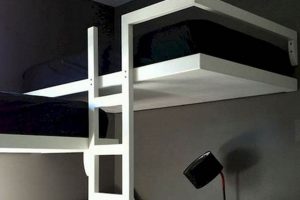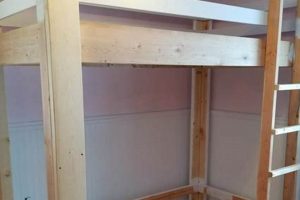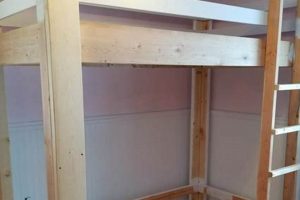The practice of using elevated temperatures to eradicate Cimex lectularius through self-directed methods involves utilizing various heating devices and strategies to subject infested areas to lethal heat levels. An example includes employing electric heaters and strategically positioning them within a room to achieve a sustained temperature above 120F (49C) for a defined period, aiming to eliminate all life stages of the insect.
This approach offers a potentially cost-effective alternative to professional pest control services. Successfully executed, it can minimize chemical exposure within a dwelling. Historically, heat has been recognized as an effective pest control method, with advancements in technology allowing for more precise and accessible application in residential settings. This offers increased control over the treatment process and timing for occupants.
The subsequent discussion will delve into the essential equipment, preparation procedures, safety precautions, execution techniques, and limitations associated with attempting this method. A thorough understanding of these aspects is crucial for responsible and effective implementation.
Essential Guidance for Heat Application Against Bed Bugs
Effective implementation requires meticulous planning and adherence to safety protocols. Success hinges on achieving and maintaining lethal temperatures throughout the infested area.
Tip 1: Conduct a Thorough Inspection: Prior to initiating any procedure, a detailed inspection is paramount. Identify all areas of infestation, paying close attention to seams of mattresses, box springs, furniture crevices, and wall junctions. This ensures comprehensive treatment.
Tip 2: Seal and Prepare the Treatment Area: Seal the room or area to be treated. This helps contain the heat. Remove items that could be damaged by high temperatures, such as wax candles, electronics, and aerosols. Proper preparation minimizes potential damage.
Tip 3: Employ Calibrated Temperature Monitoring: Use multiple calibrated thermometers placed throughout the room, including within potential hiding places. This is critical for verifying that lethal temperatures (above 120F or 49C) are consistently maintained.
Tip 4: Achieve and Maintain Lethal Temperatures: Elevate the temperature gradually to the target range and maintain it for a minimum of several hours. Prolonged exposure at lethal temperatures is necessary to ensure complete eradication of all life stages, including eggs.
Tip 5: Agitate Infested Items During Treatment: During the heating process, periodically agitate mattresses, furniture, and other potentially infested items. This disrupts harborage and helps ensure heat penetration to hidden bed bugs.
Tip 6: Exercise Extreme Caution with Electrical Systems: Employ appropriate extension cords and avoid overloading circuits. Ensure adequate ventilation to prevent overheating of heating equipment. Electrical safety is paramount to prevent fire hazards.
Tip 7: Monitor for Potential Fire Hazards: Remain vigilant for any signs of fire or smoke. Keep a fire extinguisher readily accessible. Continuous monitoring during the treatment process is crucial for safety.
Tip 8: Post-Treatment Inspection: Following treatment, conduct a thorough inspection to assess the effectiveness. Look for signs of live bed bugs. If evidence of ongoing infestation persists, consider repeating the process or seeking professional assistance.
Adhering to these tips significantly increases the likelihood of successful eradication while minimizing the risks associated with the practice.
The subsequent section will address potential pitfalls and limitations of this approach, emphasizing the importance of realistic expectations.
1. Preparation Thoroughness
The effectiveness of self-managed heat application against Cimex lectularius is directly correlated with the thoroughness of the preparation phase. Inadequate preparation compromises the treatment’s ability to achieve lethal temperatures in all infested areas, potentially resulting in treatment failure and the persistence of the infestation. The cause-and-effect relationship is evident: meticulous preparation leads to greater treatment efficacy, while insufficient preparation diminishes it. For example, neglecting to remove items that act as insulators, such as tightly packed clothing or bedding, prevents heat from penetrating and reaching bed bugs harbored within, rendering the heating process ineffective in those specific zones. The consequences extend to requiring additional rounds of heating or needing professional intervention.
Preparation thoroughness encompasses several key actions. Firstly, decluttering the space is essential, as it removes obstacles to heat distribution and exposes potential hiding places. Secondly, sealing the treatment area minimizes heat loss and ensures that the target temperature can be reached and maintained. Thirdly, identifying and addressing all potential harborage areas, such as mattresses, furniture, and cracks in walls, allows for direct targeting of these zones with heat. These steps, combined, increase the likelihood that heat permeates all areas where bed bugs may reside. Without such preparation, achieving and sustaining lethal temperatures within those locations becomes highly improbable. Imagine attempting to bake a cake in an oven that cannot maintain a consistent temperature the result would be undercooked and unsatisfactory; similarly, an incomplete strategy may render the endeavor futile.
In summary, comprehensive planning and execution during the preparatory phase are not merely recommended but are integral to the success of this approach. The challenges associated with improper preparation, such as treatment failure and persistent infestation, underscore the importance of meticulous attention to detail. The connection between “preparation thoroughness” and successful eradication highlights its role as a cornerstone of effective, self-managed heat treatment.
2. Temperature monitoring
The success of self-directed thermal remediation relies critically on meticulous temperature monitoring. It is a non-negotiable element, impacting efficacy and safety. Accurate temperature monitoring confirms that lethal heat levels, typically above 120F (49C), are achieved and maintained for a sustained duration throughout the infested area. This sustained exposure is essential for eradicating all life stages, including eggs, which exhibit greater heat resistance than adult insects. Without proper monitoring, reliance on estimations or assumptions leads to the risk of under-treating certain zones, permitting survival and subsequent re-infestation, which would then create a futile outcome.
The practical application of temperature monitoring involves strategically placing calibrated thermometers throughout the space, including within potential harborage areas, such as within mattresses, inside furniture crevices, and near wall junctions. Regular readings from these thermometers provide data confirming that lethal temperatures are consistently maintained. Furthermore, monitoring facilitates identifying areas where heat penetration may be inadequate, allowing for adjustments in heater placement or air circulation. For instance, if a thermometer placed within a mattress consistently registers lower temperatures than the target, agitating the mattress or increasing the heat directed at it may rectify the issue. Failure to do so risks the survival of bed bugs harbored within the mattress. The information gained from temperature monitoring is essential for guiding operational decisions during treatment. Any deviation from the parameters can lead to failure.
In summary, temperature monitoring is an indispensable component of self-applied heat treatment against Cimex lectularius. It ensures the achievement and maintenance of lethal temperatures in all infested areas, informs operational adjustments, and mitigates the risk of treatment failure. The challenges associated with achieving consistent and accurate readings underscore the need for meticulous planning and execution in temperature monitoring, ensuring the heat treatment is both effective and safe. The understanding gained from thorough monitoring is not merely desirable; it is fundamental to effective pest eradication.
3. Safety protocols
The implementation of stringent safety protocols is inextricably linked to the viability of attempting self-managed thermal remediation. Employing high-temperature environments in residential settings introduces inherent risks, primarily fire and electrical hazards. Adherence to prescribed protocols mitigates these dangers, ensuring occupant safety and property protection. Ignoring safety measures elevates the likelihood of adverse events, ranging from minor property damage to severe injury or fatal consequences. For example, using unapproved extension cords can overload electrical circuits, igniting fires within walls or appliances. The direct correlation between protocol adherence and risk mitigation establishes the primacy of safety in the implementation of the eradication technique.
Specific safety measures encompass several critical areas. Firstly, electrical safety mandates the use of appropriately rated extension cords, avoidance of circuit overloading, and regular inspection of electrical equipment for defects. Secondly, fire safety necessitates the removal of flammable materials from the treatment area, maintaining adequate ventilation, and keeping fire extinguishers readily accessible. Thirdly, occupant safety requires clear communication with all household members regarding the treatment process, ensuring awareness of potential hazards, and establishing evacuation procedures. Lastly, avoiding overheating of items is a necessary safety protocol as certain materials can off-gas or combust if overheated. Implementing these measures effectively reduces the potential for incidents, enabling responsible and controlled application of the thermal remediation method. Omitting even one of these steps introduces vulnerabilities that increase the overall risk profile of the undertaking.
In summary, strict adherence to safety protocols is not merely a recommendation but is a fundamental prerequisite for attempting self-directed thermal remediation. The connection between proactive safety measures and the prevention of adverse events underscores the imperative of prioritizing safety at every stage of the treatment process. Understanding and implementing these protocols transforms the potentially hazardous process into a manageable and relatively safe procedure, protecting individuals and property from harm. The ability to connect treatment to safety protocols are interlinked to success.
4. Equipment adequacy
Effective self-directed heat application against Cimex lectularius hinges on the selection and utilization of appropriate equipment. Inadequate equipment undermines the ability to achieve and maintain lethal temperatures across the infested area, rendering the treatment ineffective. The relationship between equipment capacity and treatment outcome is direct: insufficient heating capacity leads to treatment failure, while appropriate equipment facilitates successful eradication. For example, relying on a single small space heater in a large room will likely prove inadequate, as the heater may struggle to elevate the ambient temperature to lethal levels, leaving sections of the room untreated and allowing bed bugs to survive. This underestimation of required heating power negates the purpose of the treatment.
Adequacy encompasses several critical factors, including heater capacity (measured in BTUs or wattage), air circulation capabilities (fans), and the ability to monitor and control temperature. The capacity of heating units must be sufficient to elevate the ambient temperature of the treatment area to at least 120F (49C) and maintain that temperature for a sustained period, typically several hours. Fans are crucial for ensuring even heat distribution, preventing hot spots and cold spots within the room. Calibrated thermometers, placed strategically throughout the area, provide essential data for monitoring temperature and making adjustments as needed. Choosing the correct size and number of heaters for the target space are important. A successful treatment includes using multiple heaters and many strategically placed fans.
In summary, careful consideration of equipment adequacy is crucial for effective thermal remediation in DIY settings. Insufficient heating power, poor air circulation, or inadequate monitoring capabilities will invariably lead to treatment failure, resulting in persistent infestation and wasted effort. The challenges associated with accurately assessing equipment requirements underscore the need for meticulous planning and the potential benefits of consulting with pest control professionals. Selecting appropriate equipment transforms a potentially futile effort into a viable treatment strategy, maximizing the likelihood of successful Cimex lectularius eradication. These steps combined offer the best chances of success.
5. Post-treatment verification
Following any heat application targeting Cimex lectularius, verification is an essential step to ascertain treatment efficacy and prevent recurrence. The absence of a rigorous verification process renders the entire undertaking speculative, exposing the treated environment to potential re-infestation and negating the resources invested.
- Visual Inspection
A thorough visual inspection of all previously infested areas is paramount. This includes examining mattress seams, box springs, furniture crevices, and baseboards for any signs of live bed bugs or fresh fecal matter. The presence of even a single live insect suggests treatment failure, necessitating further action. Evidence from visual inspections directly informs decisions on potential retreatment.
- Monitoring Devices
Implementing monitoring devices, such as interceptor traps placed under furniture legs, can provide ongoing surveillance for bed bug activity. These devices capture bed bugs as they attempt to access sleeping areas. Regular inspection of these traps reveals whether surviving bed bugs remain, indicating the need for additional interventions. The data gathered helps in assessing the long-term effectiveness.
- Professional Confirmation
Engaging a qualified pest control professional to conduct a post-treatment inspection offers an independent assessment of eradication success. Professionals possess the experience and tools to identify subtle signs of infestation that might be overlooked by untrained individuals. This external confirmation enhances confidence in the treatment’s effectiveness, mitigating the risk of future infestations.
- Long-Term Vigilance
Even with successful verification, maintaining long-term vigilance is critical. Regularly inspect sleeping areas and furniture for signs of bed bug activity. Educate household members on bed bug identification and prevention strategies. This proactive approach ensures early detection of any re-infestation, allowing for prompt corrective action and preventing the recurrence of a widespread problem. Continuous monitoring is a cost-effective strategy.
These facets of post-treatment verification, taken together, transform a passive approach into an active strategy for ensuring the long-term success of Cimex lectularius elimination efforts. Integrating these verification measures into the overall eradication strategy significantly reduces the likelihood of recurrence and protects the investment of time and resources expended during the initial heating process. Vigilance and a proactive approach offer the most success.
Frequently Asked Questions
This section addresses common inquiries regarding the self-directed use of heat for Cimex lectularius eradication, providing detailed and objective answers.
Question 1: What constitutes a lethal temperature for bed bugs and their eggs?
Sustained exposure to a temperature of at least 120F (49C) is considered lethal for all life stages of Cimex lectularius, including eggs. This temperature must be maintained for a minimum of several hours to ensure complete eradication.
Question 2: How can one ensure that the heat penetrates all potential bed bug hiding places?
Preparation is paramount. This includes decluttering the space, disassembling furniture where possible, and using fans to circulate heat evenly. Thermometers placed strategically throughout the room and within potential harborage areas will aid in monitoring the thermal penetration.
Question 3: What are the most significant safety risks associated with self-applied heat treatments?
The primary risks are fire hazards due to electrical overload or proximity to flammable materials, and potential burns from contact with heating equipment. Following stringent safety protocols, including using appropriately rated extension cords and maintaining adequate ventilation, is crucial.
Question 4: Is it possible to effectively treat an entire home using self-directed heating?
Treating an entire home presents significant logistical and technical challenges. Maintaining consistent lethal temperatures across multiple rooms simultaneously is difficult without specialized equipment and expertise. Focusing on treating localized infestations is generally more manageable.
Question 5: How can one verify the success of a heat treatment after it has been completed?
Verification involves thorough visual inspections of treated areas for live bed bugs or fresh fecal matter, the use of monitoring devices (e.g., interceptor traps), and potentially, a professional inspection by a qualified pest control service.
Question 6: What are the alternatives if self-applied heat treatment proves unsuccessful?
If self-applied heat treatment fails to eradicate the infestation, professional pest control services offer alternative methods, including chemical treatments, fumigation, and whole-room heat treatments using specialized equipment. Consulting with a pest control expert is recommended.
The key takeaway from these FAQs is that while self-directed thermal eradication is a viable option, it demands meticulous planning, execution, and adherence to safety protocols. The challenges are significant and should be carefully considered before attempting this approach.
The subsequent section will provide resources for further research and professional assistance.
Conclusion
This article has explored the practice of self-directed thermal eradication of Cimex lectularius, emphasizing critical aspects such as preparation, temperature monitoring, safety protocols, equipment adequacy, and post-treatment verification. Successful implementation of this method requires meticulous attention to detail and a thorough understanding of the associated risks and limitations. Effective execution remains contingent upon sustained maintenance of lethal temperatures throughout infested areas.
Given the complexities and potential hazards involved, attempting bed bug heat treatment diy should be approached with caution. If uncertainty persists or the infestation proves extensive, seeking professional pest control services is strongly advised. The decision to proceed with this method should be based on a realistic assessment of one’s capabilities and resources, prioritizing both efficacy and safety for all occupants.







